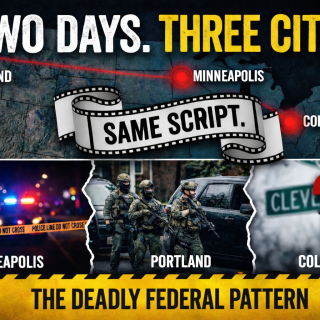The Ohio State University strikes out again. From evidence-free slogans to an ordered, bought, and delivered “consultant’s report” to Campus unSafety non-Alerts and Campus unSafety Officers, who are inactive and lack direction. Note the repetition of Campus, and not Campus and Off-Campus or university area. Is the confusion ignorance or purposeful?
Shortly following OSU’s release of the Security Risk Management Consultant’s “Off-Campus Safety Assessment Report and Recommendations,” an off-campus student reported a gunshot through the window of his East 12th Avenue rental house. That “report” was commissioned from a New Albany-based, primarily “corporate campus” security evaluation firm that had never before studied an off-campus university area. Not surprisingly, it “praised” the university’s off-campus safety measures, adding a few modest, obvious, and long-overdue recommendations and photos of everyday, illegal trash.
The expected, institutionally promised Campus Safety Alert about the gunshot never came. According to OSU student newspaper The Lantern, “other Ohio State students were left in the dark without a safety notice, typically their only way of knowing a crime had occurred.” Moreover, the students who called both the Columbus and Campus Police were informed by Campus Safety that “the case was outside their jurisdiction. Columbus Police filed a report.” What do police, much-touted Buckeye Block Watch, and powerless, invisible, private security in the University District actually do?
A university spokesman commented inaccurately that federal law requires a safety alert for on-campus offenses, but “the university is not required to issue off-campus neighborhood safety alerts.” That was that, contradicting university rhetoric and policies about safety and the unsupported conclusions of the purchased report. (See Danny Fogarty, “Off-Campus gunshots prompt discussion over how the university issues safety notices, no injuries reported.”)
Unlike President Kristina Johnson, OSU Communications, and the writer of a Feb. 24 notice in The Lantern (“Ohio State Conducts Third-Party Safety Review”), I have read the 67-page, too- little-documented Security Risk Management Consultants’ (SRMC) “Off-Campus Safety Assessment Report and Recommendations.”
I urge all members of the OSU and Columbus community not to be misled by the misrepresentations of OSU’s News Alert: “External report offers praise, recommendation to improve University District safety.”
The key word here is “praise.” This is not a research or serious consultant’s report but a commissioned, paid for, and delivered whitewash of OSU’s documented failed responses to crime both on- and off-campus historically and especially since summer 2021. As a professor and scholar, I would not accept the “Assessment Report” from a third- or fourth-year undergraduate. To begin, SRMC is unqualified. They have no experience in researching, evaluating, or making recommendations for off-campus areas. Nowhere do they or OSU state why this firm was chosen.
Moreover, the report is poorly written, disorganized, and repetitious. It contains no systematic primary research or stated methodology. It includes no systematic interviews of student renters or homeowners, CPD officers, Campus Safety officers, or relevant City of Columbus staff. When it refers to data, rather than anecdotes or OSU public relations and presidential pronouncements—or irrelevant, false comparisons with other locations—the “report” uses evidence uncritically and partially.
Astonishingly, SRMC confuses on- and off-campus. It never admits the limits of the incomplete and unverified dataor more importantly the difference between OSU administration statements coming out of Bricker Hall and the views of Columbus Police, OSU’s own Campus Security officers, or professional experts who are also University District residents. It ignores close observers who speak with CPD, campus personnel, and students, and also write factually as I do in my national higher education essays and Busting Myths columns in the Columbus Free Press. It ignores my University District neighbors who almost daily make 311 or police nonemergency reports and try to reach OSU’s nonresponsive president, Campus Safety Office, Campus Partners, and others. OSU’s concern with campus and off-campus safety is no more than a public relations campaign. Eighteen years ago, when we purchased our historic house, OSU had a constantly maintained emergency hotline and occasional patrols. Both are long gone.
The combined limits and failures of the “report” are inseparably linked with Bricker Hall’s repetitive misrepresentations of the actual patterns of criminal offenses, and the harmful—not preventive—effect of symbolic and sloganeering responses. Neither Johnson’s “famous” portable lamp posts, the part-time and directionless Buckeye Block Watch, the invisible and powerless private security patrols, nor the undeveloped, unfunded, and inadequate rhetorical commitment of only $2 million per year meet the actual needs.
Ask long-time University District homeowners like myself or the students I talk to almost daily on our walks. Neither SRMC nor Bricker Hall does. We know that OSU has failed for decades. The students are fearful and not reassured. Their expectations are not met by 10- to 20-minute self-defense videos or tiny noisemakers to use if they are confronted with a gun and/or a gang. These slogan-based “home remedies” are no more useful than Student Life slogans about “party safe”, not drinking “more than five drinks,” or not driving while drunk, posted on yard signs often placed without permission on private property and routinely thrown with other trash on yards and streets by drunken students.
This report and other regular statements are marketing documents speaking to the Board of Trustees, Republican state legislators, parents, and uncritical Columbus media, not the urgently needed commitment to anyone’s safety.
Accompanying but not supporting student lives (as opposed to Student Life with its 10 associate vice presidents) is a too-small, uninformed, and uncoordinated Office of Campus Safety. Its director is unable to answer questions. This office sends out Safety Alerts 4 to 12 hours after crimes are committed, stating falsely and misleadingly that “the victim is never responsible ... for the crime.” That message, which I have personally urged Campus Safety to drop, is dangerously untrue and misleading to students who may not know better. Tell this to the OSU undergraduate recently robbed when he agreed to meet with an unknown social media contact to sell a pair of his shoes in a dark CVS parking lot.
Some murders across the street from campus and other episodes of vandalism are never announced. What is announced is too late to be helpful. The Office refuses to answer questions about any of this. When they speak to the media, they do not report accurately or honestly.
There are too few campus police. They are uncoordinated and given false information about students, the off-campus area, and crime. So are Columbus Police who are not informed about the laws and City responsibilities for the University District. Police admit to their fears of 50 to 200 students partying drunkenly and illegally outdoors (with at least tacit acceptance by law-breaking large landlords).
Instead of actively promoting safety, researching, planning, and funding it, OSU places do-it-yourself, self-defense videos on university websites and touts its telephone call boxes. Their uselessness to young people when robbed, assaulted, or confronted with a gun is never admitted. But the students see that.
In a similar vein, unlike comparable universities, OSU says nothing about rape in fraternity houses, which is an epidemic nationally. There is also no reflection of the national movement to abolish fraternities and sororities for endless violations of university and civil laws—not the least of which are discrimination, hazing, and sexual abuse. OSU very quietly admitted last fall to 10 rapes in on-campus residences.
Almost all parts of the university refuse to respond to the illegal actions of the largest landlords and property managers of student rentals in the University District. Michael Stickney of NorthSteppe Realty, lowest-rated and most often sued by former tenants, has donated at least $5 million to OSU. He appears on the OSU website claiming to be “OSU Student Housing.” He is not. Nor does NorthSteppe Realty cooperate with either the City of Columbus or OSU. But the senior administration blocks both internal and external efforts to remove false claims from OSU’s website.
Other landlords and property managers fraudulently represent themselves as OSU student housing. The university does nothing in response to inform students or protect its interests. OSU has students rate their landlords but does not publicize the results.
Despite occasional rhetoric to the contrary, OSU has never seriously taken responsibility for its adjoining University District on which it depends historically and today for faculty, staff, and especially student housing. (See Ellen L. Manovich, “‘Time and Change Will Surely Show’: Contested Urban Development in Ohio State’s University District, 1920–2015.”)
Always a mixed neighborhood, rich in architecture and landscape, the University District shifted in recent decades primarily to students renting from profit-seeking corporate landlords. This contributed directly to an unstable mix of a diminishing number of owner-occupied historic homes and student boarders and renters in large landlord/property manager units. If the City had enforced its antiquated zoning codes and Campus Partners had ever shown interest in the University District itself, this would not have happened.
Two additional matters developed prior to press time:
1. Ohio State ended its mask mandate at 6:00 p.m. on Friday, March 11, the beginning of Spring Break. This means that students returning in nine days from across the world and many from crowded maskless beaches in Florida, the Carolinas, and the Caribbean arrive en masse with no basic preventive measures.
2. OSU just announced that it will no longer issue its failed, tardy Campus Safety Alerts for off-campus problems. Not surprisingly, it explains the change by reference to its “Safety Assessment Report.” In fact, the removal follows example after example of the single, simple warning system not functioning. The off-campus will now depend on periodic maps of “crime.”
These are the Buckeye and the Columbus Ways.
--------------------------------------------------------
Harvey J. Graff is Professor Emeritus of English and History and Ohio Eminent Scholar at The Ohio State University. He is the author of many books on social history. His Searching for Literacy: The Social and Intellectual Origins of Literacy Studies is forthcoming. His essays appear in Inside Higher Education, Times Higher Education, Washington Monthly, Academe, Publishers Weekly, Columbus Free Press, and other outlets. Specialties include the history and present condition of literacy and education including higher e



